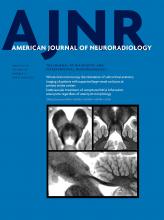Index by author
Cohen, M.
- FELLOWS' JOURNAL CLUBAdult BrainOpen AccessDisorder in Pixel-Level Edge Directions on T1WI Is Associated with the Degree of Radiation Necrosis in Primary and Metastatic Brain Tumors: Preliminary FindingsP. Prasanna, L. Rogers, T.C. Lam, M. Cohen, A. Siddalingappa, L. Wolansky, M. Pinho, A. Gupta, K.J. Hatanpaa, A. Madabhushi and P. TiwariAmerican Journal of Neuroradiology March 2019, 40 (3) 412-417; DOI: https://doi.org/10.3174/ajnr.A5958
The authors sought to investigate whether co-occurrence of local anisotropic gradient orientations (COLLAGE) measurements from posttreatment gadolinium-contrast T1WI could distinguish varying extents of cerebral radiation necrosis and recurrent tumor classes in a lesion across primary and metastatic brain tumors. On 75 gadolinium-contrast T1WI studies obtained from patients with primary and metastatic brain tumors and nasopharyngeal carcinoma, the extent of cerebral radiation necrosis and recurrent tumor in every brain lesion was histopathologically defined by a neuropathologist as the following: 1) “pure” cerebral radiation necrosis; 2) “mixed” pathology with coexistence of cerebral radiation necrosis and recurrent tumors; 3) “predominant” (>80%) cerebral radiation necrosis; 4) predominant (>80%) recurrent tumor; and 5) pure tumor. COLLAGE features were extracted from the expert-annotated ROIs on MR imaging. COLLAGE features exhibited decreased skewness for patients with pure and predominant cerebral radiation necrosis and were statistically significantly different from those in patients with predominant recurrent tumors, which had highly skewed COLLAGE values.
Correa, D.G.
- LetterYou have accessHigh-Resolution Vessel Wall MR Imaging as an Alternative to Brain BiopsyD.G. Corrêa and L.C. Hygino da CruzAmerican Journal of Neuroradiology March 2019, 40 (3) E17-E18; DOI: https://doi.org/10.3174/ajnr.A5950
Costalat, V.
- NeurointerventionYou have accessComparison of Pipeline Embolization Device Sizing Based on Conventional 2D Measurements and Virtual Simulation Using the Sim&Size Software: An Agreement StudyJ.M. Ospel, G. Gascou, V. Costalat, L. Piergallini, K.A. Blackham and D.W. ZumofenAmerican Journal of Neuroradiology March 2019, 40 (3) 524-530; DOI: https://doi.org/10.3174/ajnr.A5973
Crandall, L.
- EDITOR'S CHOICEAdult BrainOpen Access3T MRI Whole-Brain Microscopy Discrimination of Subcortical Anatomy, Part 1: Brain StemM.J. Hoch, M.T. Bruno, A. Faustin, N. Cruz, L. Crandall, T. Wisniewski, O. Devinsky and T.M. ShepherdAmerican Journal of Neuroradiology March 2019, 40 (3) 401-407; DOI: https://doi.org/10.3174/ajnr.A5956
The authors applied an optimized TSE T2 sequence to washed postmortem brain samples to reveal exquisite and reproducible brain stem anatomic MR imaging contrast comparable with histologic atlases. Direct TSE MR imaging sequence discrimination of brain stem anatomy can help validate other MR imaging contrasts, such as diffusion tractography, or serve as a structural template for extracting quantitative MR imaging data in future postmortem investigations.
Cruz, N.
- EDITOR'S CHOICEAdult BrainOpen Access3T MRI Whole-Brain Microscopy Discrimination of Subcortical Anatomy, Part 1: Brain StemM.J. Hoch, M.T. Bruno, A. Faustin, N. Cruz, L. Crandall, T. Wisniewski, O. Devinsky and T.M. ShepherdAmerican Journal of Neuroradiology March 2019, 40 (3) 401-407; DOI: https://doi.org/10.3174/ajnr.A5956
The authors applied an optimized TSE T2 sequence to washed postmortem brain samples to reveal exquisite and reproducible brain stem anatomic MR imaging contrast comparable with histologic atlases. Direct TSE MR imaging sequence discrimination of brain stem anatomy can help validate other MR imaging contrasts, such as diffusion tractography, or serve as a structural template for extracting quantitative MR imaging data in future postmortem investigations.
Cudkowicz, M.E.
- MemorialYou have accessRobert H. Ackerman, MD, MPH (1935–2018)M.H. Lev, J.M. Romero, L.H. Schwamm, M.E. Cudkowicz and J.A. BrinkAmerican Journal of Neuroradiology March 2019, 40 (3) E12-E13; DOI: https://doi.org/10.3174/ajnr.A5989








